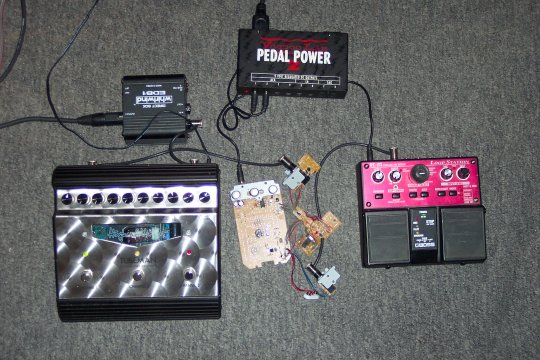| TS7 Blindfold Tests /\ | ||
|
Check out my YouTube channel. |
The Tube Screamer is often used to boost the signal to a higher level to overload the input of a tube amplifier. In these situations, the sound coming out of the Tube Screamer is mostly free of distortion. Test Rig 2 is designed to test the Tube Screamer's sound in this situation.

+-------+ +-----+ +---------+ +-----------+ +-----------+ +----------+ +----+
| Boss |--->| TS7 |--->| H & K |------------>| Whirlwind |--->| Alesis |-->| Event |-->| PC |
| RC-20 | | | | Tubeman | "To | EDB-1 | | Studio 24 | | Layla 20 | | |
+-------+ +-----+ +---------+ Mixer" | Direct | | 24 Mixer | +----------+ +----+
Output | Box | +-----------+
+-----------+
The TS7 Tube Screamer's knobs are set as follows:
| Drive: | Minimum |
| Tone: | 12:00 |
| Level: | Maximum |
The TS7's output is used to overload the input of a Hughes and Kettner Tubeman tube preamp pedal. The Tubeman has three channels: clean, mild distortion, and heavy distortion. It also has two outputs, "To Mixer", in which the signal runs first through a speaker simulating filter much like the "Red Box", and "To Guitar Amp" which does not pass through this filter. I used the "To Mixer" output to more closely simulate a real tube guitar amplifier.
The Tubeman is used because it has a real tube preamp, but since it runs direct, there will be no variations in sound introduced by other factors like room acoustics, microphone placement, etc.
In this test rig, The Tubeman is set on Channel 1 (the clean channel) with the knobs set as follows:
| Channel 1 Level: | 12:00 |
| Bass: | 11:30 |
| Mid: | 12:00 |
| Treble: | 12:30 |
| Master Vol: | 2:00 |
The Tubeman's "To Mixer" output then goes through a Whirlwind EDB1 direct box, into my Alesis HR24 mixer, then into my Event Layla 20 sound card, and into CoolEdit running on my PC.